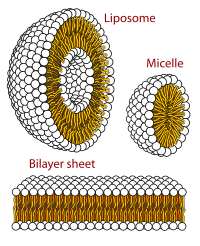
Photo from wikipedia
Lipid-based formulations (LBFs) are a popular strategy for enhancing the gastrointestinal solubilization and absorption of poorly water-soluble drugs. In light of this, montmorillonite-lipid hybrid (MLH) particles, composed of medium-chain triglycerides,… Click to show full abstract
Lipid-based formulations (LBFs) are a popular strategy for enhancing the gastrointestinal solubilization and absorption of poorly water-soluble drugs. In light of this, montmorillonite-lipid hybrid (MLH) particles, composed of medium-chain triglycerides, lecithin and montmorillonite clay platelets, have been developed as a novel solid-state LBF. Owing to the unique charge properties of montmorillonite, whereby the clay platelet surfaces carry a permanent negative charge and the platelet edges carry a pH-dependent charge, three model poorly water-soluble drugs with different charge properties; blonanserin (weak base, pKa 7.7), ibuprofen (weak acid, pKa 4.5) and fenofibrate (neutral), were formulated as MLH particles and their performance during biorelevant in vitro lipolysis at pH 7.5 was investigated. For blonanserin, drug solubilization during in vitro lipolysis was significantly reduced 3.4-fold and 3.2-fold for MLH particles in comparison to a control lipid solution and silica-lipid hybrid (SLH) particles, respectively. It was hypothesized that strong electrostatic interactions between the anionic montmorillonite platelet surfaces and cationic blonanserin molecules were responsible for the inferior performance of MLH particles. In contrast, no significant influence on drug solubilization was observed for ibuprofen- and fenofibrate-loaded MLH particles. The results of the current study indicate that whilst MLH particles are a promising novel formulation strategy for poorly water-soluble drugs, drug ionization tendency and the potential for drug-clay interactions must be taken into consideration to ensure an appropriate performance.
Journal Title: International journal of pharmaceutics
Year Published: 2017
Link to full text (if available)
Share on Social Media: Sign Up to like & get
recommendations!